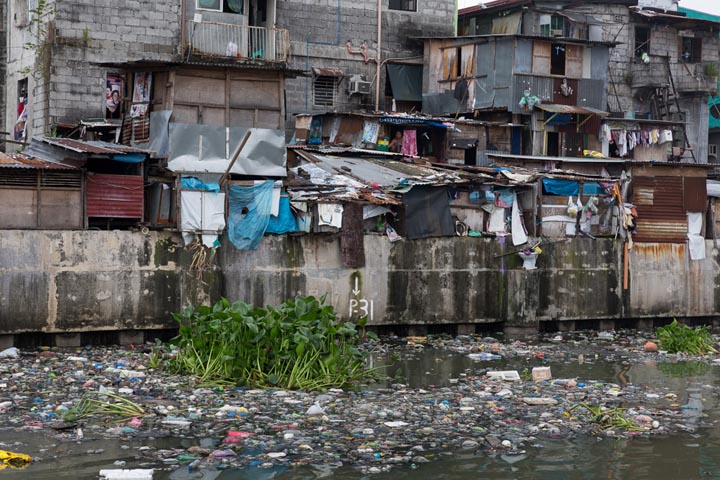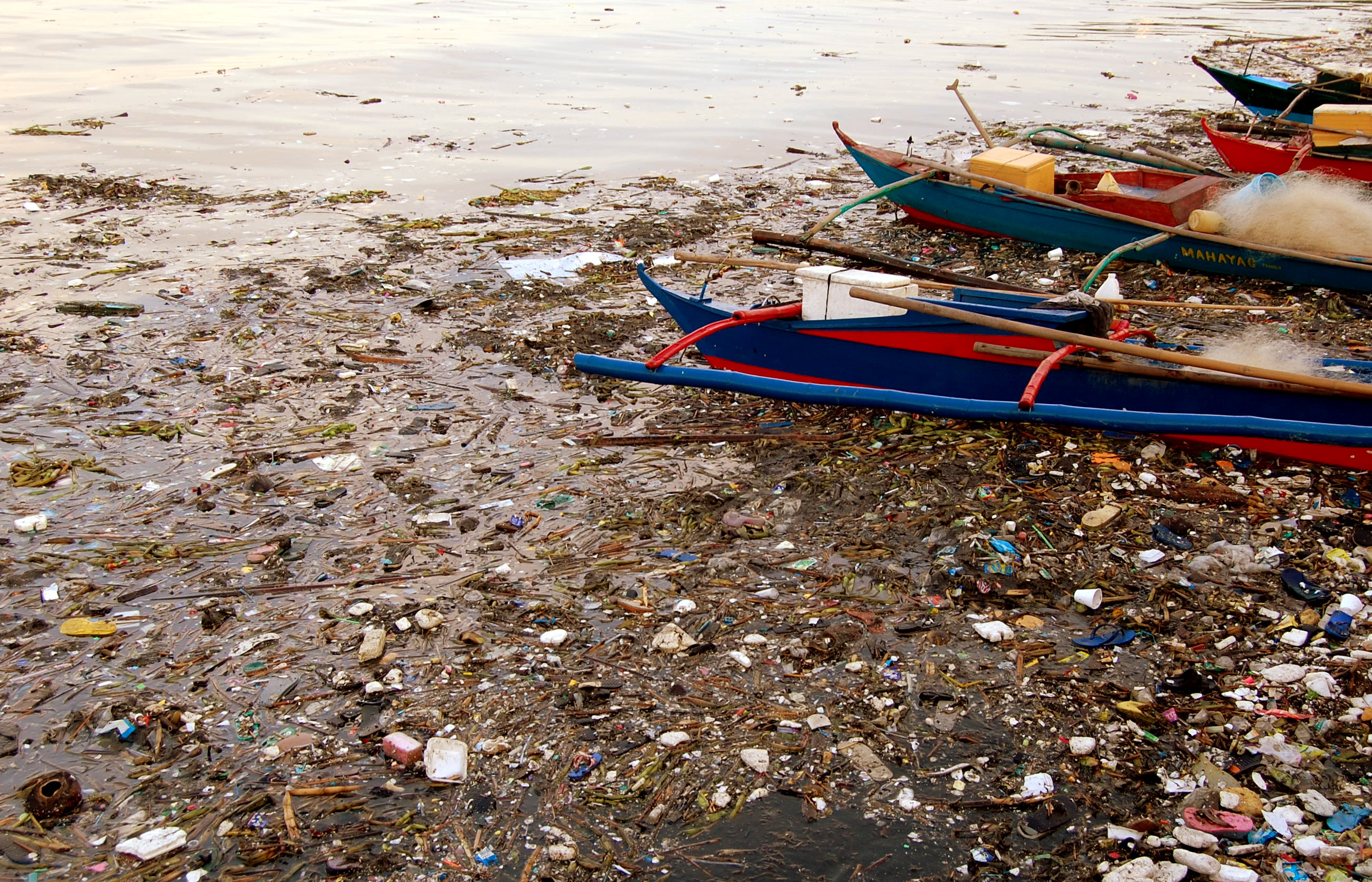- hot-spots
- rivers
- Philippines
- Water pollution Pasig River in the Philippines

Problems
Environmental hotspot in the Philippines
One of the main rivers of the Philippines, the Pasig River was once praised for its beauty. It encompasses in its system many smaller rivers and tributaries, six subbasins, and Manila Bay. It is the primary river supporting the area known as Metro Manila, the capital city of Manila, and its surrounding metropolis. Since the end of World War II, the Pasig River has been the primary recipient of much of the pollution produced by Metro Manila’s ten million inhabitants. The population along the Pasig River has continued to multiply, but the developing country’s ability to cope with waste disposal has not kept up. Initially used for bathing and fishing, the river has become Manila's “toilet bowl”. Pollution dumped into the river and its tributaries have accumulated and can no longer sustain any life other than janitor fish and water lilies. Ecologists consider it dead. Although many laws and plans have been put into place to regulate pollution and clean the water, none have proven effective.
Water Pollution
The main source of pollution in the Pasig River is garbage and untreated domestic and industrial sewage. In 2025, it is estimated that water availability will be negligible in most major cities and in 8 of the 19 major river basins. In addition to serious health problems, water pollution also causes problems in the fishing and tourism industries. The national government has recognized this problem and since 2004 has sought to introduce sustainable water development management. The pollution of the Pasig River affects the people of the Philippines. Only 5% of the entire population is connected to a sewage system. The vast majority use flush toilets connected to septic tanks. Because sewage treatment plants and disposals are rare, most wastewater is discharged untreated. According to the Asian Development Bank, the Pasig River is one of the most polluted rivers in the world. In March 2008, Manila Water announced that a wastewater treatment plant would be built in Taguig. In 2006, the first wetland complex built in the Philippines, serving about 700 households, was completed in a suburban area of Bayawan City and used to resettle families living along the coast in informal settlements without access to safe water and sanitation.
Problems with cleaning up the Pasig River
Pasig environmental activists collect 80 to 100 bags of trash every day, and during the monsoon season, that number can reach 1,000 bags in a single day. "We are confident that we can make the river cleaner. We are doing it for our children, our parents, our nation, and Mother Nature," said activist Angelita Imperio. The authorities support the river warriors and pay for their work. However, simply cleaning the river mechanically is not enough. The country's Department of Environment and Natural Resources said they plan to relocate people living along the Pasig River illegally and punish commercial enterprises that dump trash and other waste into the river. A Greenpeace representative in the Philippines said that it was also necessary to allow residents to buy waste-free goods. "I've seen it done in other cities and countries, so I think it's possible to revive and clean up the Pasig River. But it will require collective action not only by the people who live along the river banks but also by the local government," said Marian Ledesma, Greenpeace Philippines representative.
Solutions
San Miguel Corp
Author: San Miguel Corp
SMC said it is allocating P2 billion for its five-year plan to clean up the Pasig River. Described as the “largest-ever river rehabilitation project in the country,” it will involve extracting 50,000 metric tons of silt and solid waste per month from the river, or 600,000 metric tons a year using advanced and specialized equipment. The project is supported by the departments of Environment, Public Works, Interior and Local Government, Philippine Coast Guard, and local government units, including Manila, Mandaluyong, Makati, and Pasig.
Gallery
4Timelines
2023
March
San Miguel Corporation (SMC), which has taken for itself the gargantuan task of cleaning up major river systems in and around Metro Manila, reported that its cleanup of the 15-kilometer San Juan River, a main tributary of the Pasig River, is well underway, with over 90,000 metric tons of silt and solid waste already extracted. SMC President and CEO Ramon S. Ang, the effort, which is part of SMC’s much larger Pasig River cleanup initiative, has successfully removed waste that has been choking different sections of the river that spans the cities of Manila, Mandaluyong, San Juan, and Quezon City. Since work commenced last October, Ang said that SMC’s crews have cleaned up a total of 3.1 kilometers, covering sections of the river from Sta. Mesa to Sta. Ana, San Juan to Mandaluyong, and from Dona Imelda to Tatalon in Quezon City. From just 0.5 to 1.5 meters, dredged areas now have depths of 2.5 to four meters, enabling improved water flow and the carriage of a higher volume of floodwaters. The effort has also resulted in the widening of portions of the river that were partially blocked by stockpiled materials from construction activities. Ang said that its San Juan River cleanup, which it is undertaking with the Department of Public Works and Highways (DPWH), Department of Environment and Natural Resources (DENR), and local government units (LGU), is crucial to maintaining the gains that SMC has already made in cleaning up the Pasig River.
2021
September 29
According to a report, Metro Manila’s largest pumping station has been damaged by an estimated 2 tons of trash being collected daily. The majority of these are plastic waste washed into Pasig river by torrential rainfall. Considering the amount of rubbish that ends up in the pumping stations, it should come as no surprise that they are damaged during the monsoon season. The stations bear the burden of the enormous amounts of solid waste that are dumped in their path. Further complicating this problem is the increase of single-use plastics and disposable personal protective equipment (PPE) generating an estimated 52,000 metric tons of medical waste amid the pandemic.
June 10
“The world’s most polluting river when it comes to plastic is the 27-kilometer Pasig River which runs through Metro Manila, accounting for 63,000 tons of plastic entering oceans from rivers per year,” a statement from the Climate Change Commission (CCC) read. The Philippines has the highest average probability of a plastic particle reaching the ocean in a year, at 7.2%. “The study findings raise extreme concern on the issue of mismanaged plastic wastes in the country, and supports the call…for urgent efforts to solve the plastic crisis by implementing measures to regulate and in turn, halt the production of unnecessary plastics-made straws and stirrers, spoon and fork, and plastic labo, among others,” CCC said.
2019
February 10
A separate study by Parnoda et al. in 2019 explained that different seasons and astronomical tides affect river flow patterns and heavy metal concentrations in the Pasig River. The paper found that low flow during the dry season can lead to the deposition of heavy metals such as lead, copper, nickel, and cadmium in river silt. This can lead to turbidity in the water and the coating of the riverbed. According to the study, inorganic wastes can smother riverbeds with toxic residues and cloud the water.
2016
April 12
According to Gina Lopez, chairwoman of the Pasig River Rehabilitation Commission, the national government spends 10 billion pesos ($240 million) a year cleaning up the river and its 47 tributaries. Half of that money is spent trying to relocate some 300,000 settlers who live directly on the banks of the Pasig. According to her, as long as illegal residents use the river as a toilet and garbage dump, it is not worth even thinking about cleaning it up.
2012
March 15
DENR-NSWMC (National Solid Waste Management Commission) showed in 2012 that solid waste generation in Metro Manila is about 8,200 tons per day. A study published in AAAS also showed that the Pasig River, a major source of global ocean pollution, discharges about 38,000 tons of plastic into the oceans each year. That's at least 6.43 percent of global ocean plastic pollution.
2010
January 01
According to a separate 2010 study by experts Joan Gorme, Marla Manikiz, Pum Song, and Lee-Hyun Kim, household waste accounts for 60 percent of the total pollution in the Pasig River. At least 33 percent comes from industrial waste from manufacturing plants such as tanneries, textiles, food, alcohol, and chemical and metallurgical plants. At least seven percent is clearly visible-solid waste is dumped directly into the river.


